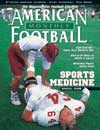AMERICAN FOOTBALL MONTHLY THE #1 RESOURCE FOR FOOTBALL COACHES
Article CategoriesAFM Magazine
|
Letter From the Publisher© More from this issueProtecting your assets... In the business world, there are a few axioms that are universally applied by all successful companies. For example, some of these management philosophies are: focus on those things with the greatest opportunity for success; make certain you do whatever is necessary to keep your best employees; and protect your company's most valuable assets. However, in the football world, I fear teams sometimes ignore sound, proven and winning business strategies that could help coaches manage their teams more efficiently and win more games. The most fundamentally sound of all business practices is put into place when managers and owners make absolutely certain they do everything possible to protect their most valuable assets. If a printing company applies this philosophy, they make certain their p....The full article can only be seen by subscribers. Subscribe today!
|
|
|||||||
| HOME |
MAGAZINE |
SUBSCRIBE | ONLINE COLUMNISTS | COACHING VIDEOS |
Copyright 2025, AmericanFootballMonthly.com
All Rights Reserved





